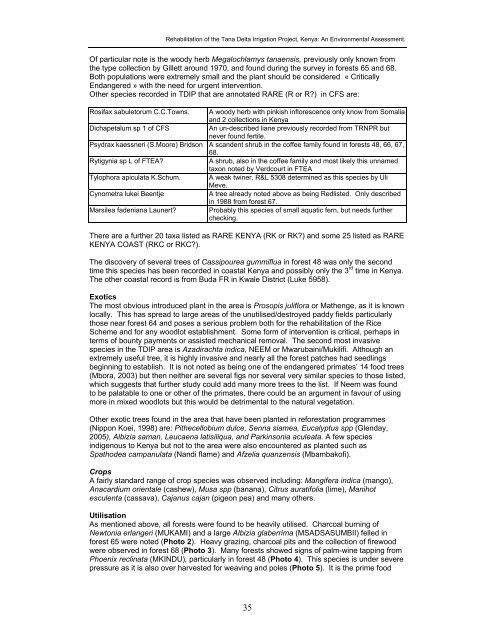Tana Delta Irrigation Project, Kenya: An Environmental Assessment
Tana Delta Irrigation Project, Kenya: An Environmental Assessment
Tana Delta Irrigation Project, Kenya: An Environmental Assessment
You also want an ePaper? Increase the reach of your titles
YUMPU automatically turns print PDFs into web optimized ePapers that Google loves.
Rehabilitation of the <strong>Tana</strong> <strong>Delta</strong> <strong>Irrigation</strong> <strong>Project</strong>, <strong>Kenya</strong>: <strong>An</strong> <strong>Environmental</strong> <strong>Assessment</strong>.<br />
Of particular note is the woody herb Megalochlamys tanaensis, previously only known from<br />
the type collection by Gillett around 1970, and found during the survey in forests 65 and 68.<br />
Both populations were extremely small and the plant should be considered « Critically<br />
Endangered » with the need for urgent intervention.<br />
Other species recorded in TDIP that are annotated RARE (R or R?) in CFS are:<br />
Rosifax sabuletorum C.C.Towns. A woody herb with pinkish inflorescence only know from Somalia<br />
and 2 collections in <strong>Kenya</strong><br />
Dichapetalum sp 1 of CFS<br />
<strong>An</strong> un-described liane previously recorded from TRNPR but<br />
never found fertile.<br />
Psydrax kaessneri (S.Moore) Bridson A scandent shrub in the coffee family found in forests 48, 66, 67,<br />
68.<br />
Rytigynia sp L of FTEA?<br />
A shrub, also in the coffee family and most likely this unnamed<br />
taxon noted by Verdcourt in FTEA<br />
Tylophora apiculata K.Schum. A weak twiner, R&L 5308 determined as this species by Uli<br />
Meve.<br />
Cynometra lukei Beentje<br />
A tree already noted above as being Redlisted. Only described<br />
in 1988 from forest 67.<br />
Marsilea fadeniana Launert? Probably this species of small aquatic fern, but needs further<br />
checking.<br />
There are a further 20 taxa listed as RARE KENYA (RK or RK?) and some 25 listed as RARE<br />
KENYA COAST (RKC or RKC?).<br />
The discovery of several trees of Cassipourea gummiflua in forest 48 was only the second<br />
time this species has been recorded in coastal <strong>Kenya</strong> and possibly only the 3 rd time in <strong>Kenya</strong>.<br />
The other coastal record is from Buda FR in Kwale District (Luke 5958).<br />
Exotics<br />
The most obvious introduced plant in the area is Prosopis juliflora or Mathenge, as it is known<br />
locally. This has spread to large areas of the unutilised/destroyed paddy fields particularly<br />
those near forest 64 and poses a serious problem both for the rehabilitation of the Rice<br />
Scheme and for any woodlot establishment. Some form of intervention is critical, perhaps in<br />
terms of bounty payments or assisted mechanical removal. The second most invasive<br />
species in the TDIP area is Azadirachta indica, NEEM or Mwarubaini/Mukilifi. Although an<br />
extremely useful tree, it is highly invasive and nearly all the forest patches had seedlings<br />
beginning to establish. It is not noted as being one of the endangered primates’ 14 food trees<br />
(Mbora, 2003) but then neither are several figs nor several very similar species to those listed,<br />
which suggests that further study could add many more trees to the list. If Neem was found<br />
to be palatable to one or other of the primates, there could be an argument in favour of using<br />
more in mixed woodlots but this would be detrimental to the natural vegetation.<br />
Other exotic trees found in the area that have been planted in reforestation programmes<br />
(Nippon Koei, 1998) are: Pithecellobium dulce, Senna siamea, Eucalyptus spp (Glenday,<br />
2005), Albizia saman, Leucaena latisiliqua, and Parkinsonia aculeata. A few species<br />
indigenous to <strong>Kenya</strong> but not to the area were also encountered as planted such as<br />
Spathodea campanulata (Nandi flame) and Afzelia quanzensis (Mbambakofi).<br />
Crops<br />
A fairly standard range of crop species was observed including: Mangifera indica (mango),<br />
<strong>An</strong>acardium orientale (cashew), Musa spp (banana), Citrus auratifolia (lime), Manihot<br />
esculenta (cassava), Cajanus cajan (pigeon pea) and many others.<br />
Utilisation<br />
As mentioned above, all forests were found to be heavily utilised. Charcoal burning of<br />
Newtonia erlangeri (MUKAMI) and a large Albizia glaberrima (MSADSASUMBII) felled in<br />
forest 65 were noted (Photo 2). Heavy grazing, charcoal pits and the collection of firewood<br />
were observed in forest 68 (Photo 3). Many forests showed signs of palm-wine tapping from<br />
Phoenix reclinata (MKINDU), particularly in forest 48 (Photo 4). This species is under severe<br />
pressure as it is also over harvested for weaving and poles (Photo 5). It is the prime food<br />
35

















